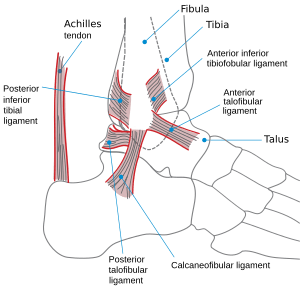Ankle facts for kids
The ankle is a very important joint in your body. It's the part that connects your foot to your lower leg. Think of it as a hinge that allows your foot to move up and down, and a little bit side to side. This movement is super important for everyday activities like walking, running, and jumping!
Contents
What is the Ankle Made Of?
Your ankle is a complex joint made up of several bones, ligaments, and tendons.
The Bones of Your Ankle
Three main bones come together to form the ankle joint:
- The tibia (shin bone): This is the larger of the two bones in your lower leg.
- The fibula: This is the thinner bone next to your tibia in your lower leg.
- The talus: This is a bone in your foot that sits right under the tibia and fibula. It's shaped a bit like a dome.
These bones fit together snugly, allowing for smooth movement.
Ligaments and Tendons
Besides bones, your ankle also has:
- Ligaments: These are strong, stretchy bands of tissue that connect bones to other bones. They act like strong ropes, holding the ankle bones together and keeping the joint stable.
- Tendons: These are tough cords of tissue that connect muscles to bones. The most famous one in your ankle area is the Achilles tendon, which connects your calf muscles to your heel bone. Tendons help your muscles move your foot.
How Does Your Ankle Move?
Your ankle joint allows for several important movements:
- Dorsiflexion: This is when you lift your foot upwards, bringing your toes closer to your shin. Think about lifting your foot off the gas pedal.
- Plantarflexion: This is when you point your foot downwards, like when you press the gas pedal or stand on your tiptoes.
- Inversion: This movement turns the sole of your foot inwards, towards your other foot.
- Eversion: This movement turns the sole of your foot outwards, away from your other foot.
These movements work together to help you walk on uneven ground, balance, and perform many sports activities.
Why is the Ankle So Important?
Your ankles are crucial for almost every movement involving your legs and feet.
- Walking and Running: Every step you take relies on your ankles. They help you push off the ground and absorb the impact when your foot lands.
- Balance: Your ankles play a big role in keeping you steady and preventing falls. They constantly make small adjustments to keep your body upright.
- Sports and Activities: Whether you play soccer, basketball, dance, or just run around, your ankles are working hard. They provide the flexibility and strength needed for quick changes in direction and powerful jumps.
Common Ankle Problems
Because your ankles work so hard, they can sometimes get injured.
- Ankle Sprains: This is one of the most common ankle injuries. It happens when the ligaments that support your ankle are stretched or torn. This often occurs when your foot twists or rolls in an awkward way.
- Ankle Fractures: A fracture means a bone in your ankle is broken. This can happen from a hard fall or a direct hit.
- Tendinitis: This is when a tendon in your ankle becomes inflamed or irritated, often from overuse.
If you ever hurt your ankle, it's important to tell an adult and get it checked out. Rest, ice, compression, and elevation (RICE) are often the first steps for minor injuries.
Keeping Your Ankles Healthy
You can do several things to help keep your ankles strong and healthy:
- Wear proper shoes: Choose shoes that fit well and provide good support for your feet and ankles, especially during sports.
- Warm up before exercise: Gentle stretches and light activity can prepare your ankle muscles and ligaments for more intense movement.
- Strengthen your ankles: Exercises like calf raises or balancing on one foot can help build strength and stability in your ankles.
- Listen to your body: If your ankle feels sore or painful, give it a rest. Don't push through pain, as this can lead to more serious injuries.
By taking care of your ankles, you can keep moving and enjoying all your favorite activities!
Images for kids
See also
 In Spanish: Tobillo para niños
In Spanish: Tobillo para niños





